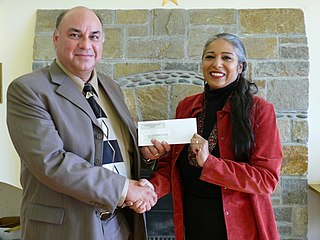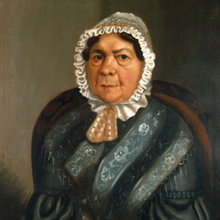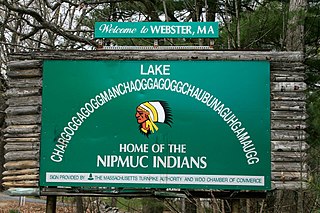
Mashpee is a town in Barnstable County, Massachusetts, United States, on Cape Cod. The population was 15,060 as of 2020. The town is the site of the headquarters and most members of the Mashpee Wampanoag Tribe, one of two federally recognized Wampanoag groups.

The Wampanoag, also rendered Wôpanâak, are a Native American people of the Northeastern Woodlands based in southeastern Massachusetts and historically parts of eastern Rhode Island. Their territory historically includes the islands of Martha's Vineyard and Nantucket.

The Pokanoket was the village governed by Massasoit. The term broadened to refer to all peoples and lands governed by Massasoit and his successors, which were part of the Wampanoag people in what is now Rhode Island and Massachusetts.

The Massachusett language is an Algonquian language of the Algic language family that was formerly spoken by several peoples of eastern coastal and southeastern Massachusetts. In its revived form, it is spoken in four communities of Wampanoag people. The language is also known as Natick or Wôpanâak (Wampanoag), and historically as Pokanoket, Indian or Nonantum.

The Massachusett were a Native American tribe from the region in and around present-day Greater Boston in the Commonwealth of Massachusetts. The name comes from the Massachusett language term for "At the Great Hill," referring to the Blue Hills overlooking Boston Harbor from the south.
Praying Indian is a 17th-century term referring to Native Americans of New England, New York, Ontario, and Quebec who converted to Christianity either voluntarily or involuntarily. Many groups are referred to by the term, but it is more commonly used for tribes that were organized into villages. The villages were known as praying towns and were established by missionaries such as the Puritan leader John Eliot and Jesuit missionaries who established the St. Regis and Kahnawake and the missions among the Huron in western Ontario.
State-recognized tribes in the United States are organizations that identify as Native American tribes or heritage groups that do not meet the criteria for federally recognized Indian tribes but have been recognized by a process established under assorted state government laws for varying purposes or by governor's executive orders. State recognition does not dictate whether or not they are recognized as Native American tribes by continually existing tribal nations.

The Nipmuc or Nipmuck people are an Indigenous people of the Northeastern Woodlands, who historically spoke an Eastern Algonquian language. Their historic territory Nippenet, "the freshwater pond place," is in central Massachusetts and nearby parts of Connecticut and Rhode Island.

Praying towns were settlements established by English colonial governments in New England from 1646 to 1675 in an effort to convert local Native Americans to Christianity.

The Hassanamisco Nipmuc Band is the sole state-recognized tribe in the Commonwealth of Massachusetts. They were recognized in 1976 by Governor Michael Dukakis via Executive Order 126. They were known as the Nipmuc Nation during their unsuccessful attempt to receive federal acknowledgment. The Hassanamisco Nipmuc Band owns three and a half acres of reservation land in what is present day Grafton, Massachusetts. The Nipmuc are native to Central Massachusetts, Northeastern Connecticut, and parts of Rhode Island.

The Webster/Dudley Band of Chaubunagungamaug Nipmuck Indians, also known as the Chaubunagungamaug, Chaubunagungamaug Nipmuck, Pegan or Dudley/Webster Indians, is a cultural heritage group that claims descent from the Nipmuc people. They are a state-recognized tribe by the Commonwealth of Massachusetts.

The Chaubunagungamaug Reservation refers to the small parcel of land located in the town of Thompson, Connecticut, close to the border with the town of Webster, Massachusetts and within the bounds of Lake Chaubunagungamaug to the east and the French River to the west. The reservation is used by the descendants of the Nipmuck Indians of the previous reservation, c. 1682–1869, that existed in the same area, who now identify as the Webster/Dudley Band of the Chaubunagungamaug Nipmuck. Together with the Hassanamisco Nipmuc, both have received state recognition under the Massachusetts Commission on Indian Affairs.
Quinsigamond is a place in Massachusetts.
The Mashpee Wampanoag Tribe is one of two federally recognized tribes of Wampanoag people in Massachusetts. Recognized in 2007, they are headquartered in Mashpee on Cape Cod. The other Wampanoag tribe is the Wampanoag Tribe of Gay Head (Aquinnah) on Martha's Vineyard.

The Wampanoag Tribe of Gay Head (Aquinnah) (Wampanoag: Âhqunah Wôpanâak) is a federally recognized tribe of Wampanoag people based in the town of Aquinnah on the southwest tip of Martha's Vineyard in Massachusetts, United States. The tribe hosts an annual Cranberry Day celebration.

Zara Cisco Brough, also called Princess White Flower, served as the Chief of the Nipmuc Nation, a state-recognized tribe in Massachusetts, from 1962 until 1987. She is best known for her work to preserve Nipmuc heritage.
The Massachusett dialects, as well as all the Southern New England Algonquian (SNEA) languages, could be dialects of a common SNEA language just as Danish, Swedish and Norwegian are mutually intelligible languages that essentially exist in a dialect continuum and three national standards. With the exception of Massachusett, which was adopted as the lingua franca of Christian Indian proselytes and survives in hundreds of manuscripts written by native speakers as well as several extensive missionary works and translations, most of the other SNEA languages are only known from fragmentary evidence, such as place names. Quinnipiac (Quiripey) is only attested in a rough translation of the Lord's Prayer and a bilingual catechism by the English missionary Abraham Pierson in 1658. Coweset is only attested in a handful of lexical items that bear clear dialectal variation after thorough linguistic review of Roger Williams' A Key into the Language of America and place names, but most of the languages are only known from local place names and passing mention of the Native peoples in local historical documents.
The Pokanoket Nation, also known as the Pokanoket Tribe, is one of several cultural heritage organizations of individuals who identify as descendants of the Wampanoag people in Rhode Island and Massachusetts. They formed a nonprofit organization called the Council of Seven & Royal House of Pokanoket & Pokanoket Tribe & Wampanoag Corporation in 1994.
The Herring Pond Wampanoag Tribe is a cultural heritage group that claims descent from the Wampanoag people based in Plymouth, Massachusetts. They have a nonprofit organization, the Herring Pond Wampanoag Tribal Council, Inc.











